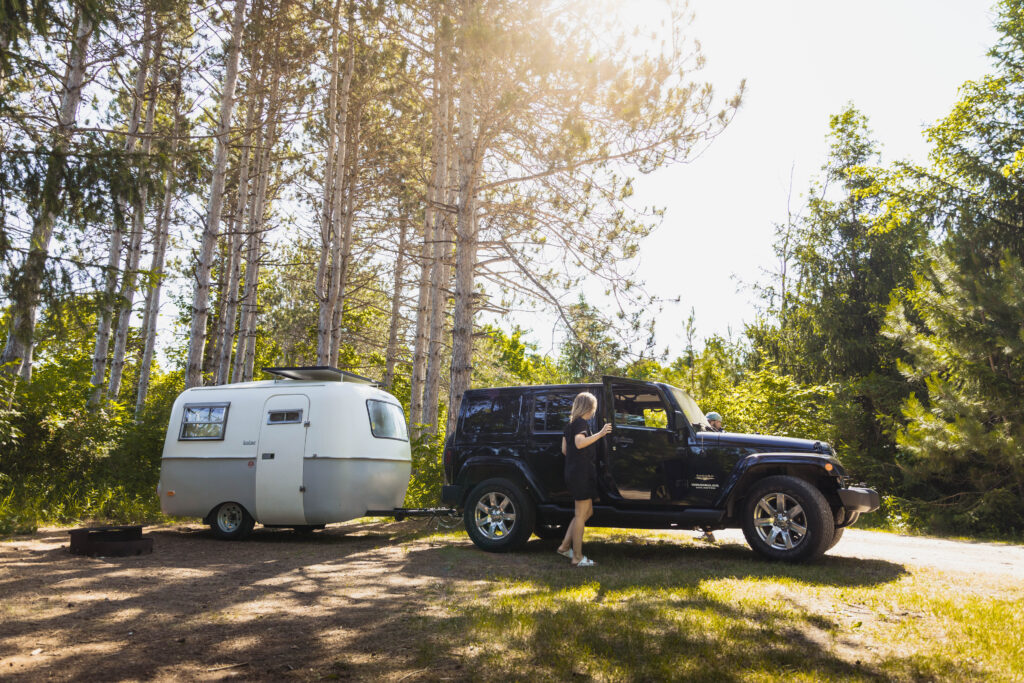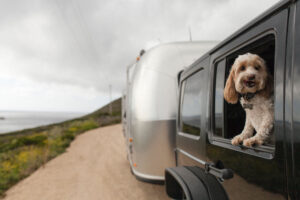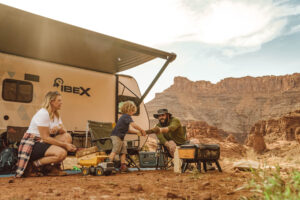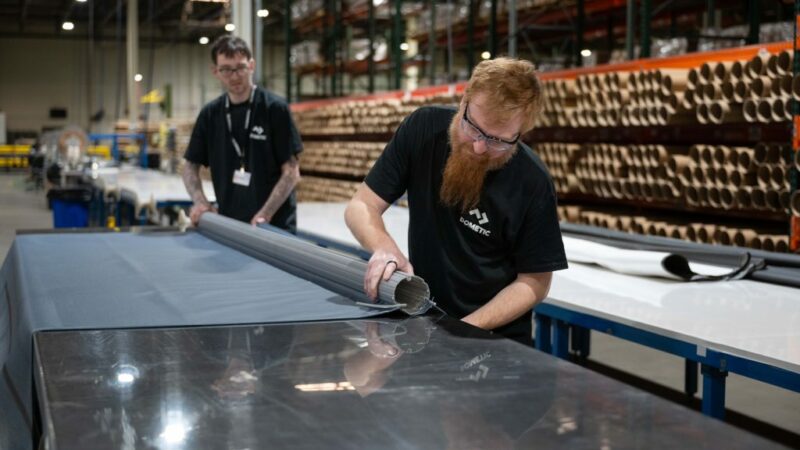RVIA Explores the Big Evolution of the Small Travel Trailer

EDITOR’S NOTE: The following is a News & Insights report by the RV Industry Association.
“The more things change, the more they remain the same.” This French maxim from the mid-1800’s is surprisingly fitting for the motivations behind – and creations of – America’s small travel trailer manufacturers over the past century. Consumers’ desire to see and experience the country in a mobile vacation home, pulled by a standard vehicle of the day, over unpaved roadways into un-electrified hinterlands, still drives the design and sales of these RVs.
Whether it’s the ongoing “spirit of adventure” described by nuCamp’s Scott Hubble or a “desire to get up close and spend more time with Mother Nature,” according to Airstream’s Tim Maxwell, Americans seem to be returning to camping in much the same way as their forefathers, but in far more comfort.
Forest River, which launched its R-pod series in 2008, initially thought their market would be first-time buyers, but it was Baby Boomers who led the small travel trailer trend. Today, millennial individuals, couples, and small families are catching up and all are driving innovation in the industry.
It was the Conestoga Wagon that constituted the original version of the travel trailer, transporting settlers west and enabling early “remote workers” to pedal their wares. But once the automobile was invented, it wasn’t long before motorized camping began. The 1920s versions of these trailers, homemade and still cobbled together primarily out of wood and canvas, were necessarily lightweight because the Ford Model T was not powerful enough to pull anything heavier. By the 1930’s, however, Airstream’s aluminum-bodied trailers were introduced.
 The first Airstream models were lightweight and teardrop-shaped to maximize aerodynamics and to allow for standing space in the center. Almost 100 years later, this is still popular for these same reasons and others. Intech’s Luna model, for instance, was launched in 2016 with the teardrop shape and an all-aluminum cage.
The first Airstream models were lightweight and teardrop-shaped to maximize aerodynamics and to allow for standing space in the center. Almost 100 years later, this is still popular for these same reasons and others. Intech’s Luna model, for instance, was launched in 2016 with the teardrop shape and an all-aluminum cage.
The relative low weight of small travel trailers, which can range from 2,000-5,000 lbs. gross vehicle weight rating (GVWR), continues to meet the need (or desire) of consumers to use the standard vehicles of the day for towing. European RV manufacturers have long led in the design of small travel trailers out of necessity because the average vehicles there are smaller than in America. nuCamp’s soon-to-be-available “Barefoot” model is an example. Designed in the UK, the sleek, fiberglass body unit weighs in at the bottom of the GVWR range. But even those trailers near the top can be towed by small SUVs, Toyota 4-Runners, and Subaru Outbacks.
Brian Wilkins, the owner of Wilkins RV in central New York, carries the Venture Sonic Lite, which he says is “easy to tow and a means to get outside.”
“A fridge, heater, and bed are all that’s needed,” says Wilkins, who has seen steady sales of entry-level trailers throughout 2022. But pricing has changed since COVID, he cautions, “so the industry has to figure out what customers will spend.”
The lower weight trailers also provide the benefit of requiring less gas to tow, which has been a concern to travel trailer owners at different points in past and recent history.
Unlike their camping ancestors, who were forced to traverse over largely unpaved roadways, many of today’s small RV owners are choosing to travel off-road. The industry has met this challenge with significant improvements in suspensions, tires, cage construction, and even interior features, like tie-downs for gear and accessories.
The Forest River No Boundaries (NoBo) series and the Ember Overland models both feature independent suspensions, a coil system that allows each wheel of the trailer to absorb shocks and move independently.
 “An overwhelming majority of today’s towable products are still built on leaf spring suspensions; a technology that has seen little to no innovation since essentially the days of covered wagons” said Jake Daniels, Regional Sales Manager with the NoBo brand of travel trailers and toy haulers. He also notes that his brand touts their standard Curt “Beast Mode” fully independent and axle-less running gear which ensures a safe, smooth, and stable ride on both paved and un-paved pathways.
“An overwhelming majority of today’s towable products are still built on leaf spring suspensions; a technology that has seen little to no innovation since essentially the days of covered wagons” said Jake Daniels, Regional Sales Manager with the NoBo brand of travel trailers and toy haulers. He also notes that his brand touts their standard Curt “Beast Mode” fully independent and axle-less running gear which ensures a safe, smooth, and stable ride on both paved and un-paved pathways.
Ember also reinforces the walls of their trailers and bolts them to the chassis for extra durability. They, like many manufacturers of models designed for off-road travel, feature a higher ground clearance and larger, all-terrain tires. Many provide a spare, as well, and NoBo has recently introduced a standard tire pressure monitoring system similar to those found in large motorhomes.
Traveling off-road to destinations without running water or electricity is again common, but today, it’s primarily by choice. While crowded campsites may compel some RVers to boondock, others seek the adventure and peacefulness of vacationing off the grid. This has inspired manufacturers and aftermarket suppliers to design products and systems to make modern conveniences as accessible for dry camping as possible.
For basic comfort, many travel trailers today offer some form of solar capabilities, and some even offer full power management systems like the NoBo optional “Unplugged Package”, for example. This package includes 600 Watts of solar panels, hundreds of amp hours’ worth of lithium ion batteries, and an all-new high-efficiency 13.5k A/C. “Systems that power your whole unit, including appliances and the air conditioner, give today’s travelers the option to camp and to work remote virtually anywhere” said Daniels. “The industry has seen a massive uptick in demand to support that lifestyle.”
Accessories are where the evolution of small travel trailers is perhaps the most dramatic. Airstream offers over 25 accessories, ranging from first aid kits to tables, and other manufacturers offer such standard or add-on features as Bluetooth speakers, LED TVs, central vacuum systems, lockboxes for valuables, observation camera systems, and attachable tents that increase the trailers’ sleeping capacity. Many models also offer racks for kayaks, bikes, snowboards, skis, fishing rods, and luggage.
The industry has a unique opportunity to adopt many new features and technologies, believes Daniels, who expects the EV market, as well as today’s mainstream SUVs with improved tow ratings, to bring even more evolution to small travel trailers. “More integrated technologies will surface as they become more economical. I believe we’re still on the ground floor, and it’s truly exciting to see what the future holds for that realm of the industry.”
Indeed, the appearance and capabilities of the small travel trailer have changed considerably over the years, but the primary goal of compact mobile units – to enable travelers to explore, experience, and enjoy more of America’s great outdoors – has withstood the test of time.
Source: https://rvbusiness.com/rvia-explores-the-big-evolution-of-the-small-travel-trailer/







